Owais Mughal
Last month there have been several news items about the Lahore Rapid Mass Transit (LRMT) Rail project. We have tried to gather key information from many of these news items and will present it in the following as one concise post on the topic.
The proposed rail service is the main part of the Lahore Mass Transit System (LRMTS). Other components of this project include the now under construction Lahore Ring Road Project.
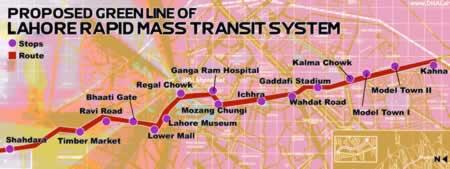
The Photo above shows the Route Map of LRMT Phase I – Green Line
The LRMT is a Two-phase, 97 kilometes long project. A Hong Kong based company called MVA Asia Consultancy was hired the government of Punjab as consultants to prepare the project feasibility. The study of MVA Asia Consultancy completed 5% of project design and proposed four Rail lines in the city to share the traffic burden. The proposed capacity of LRMT is going to be able to move 35000 passengers per hour in the city. Funding for the project will be provided by the Asian Development Bank (ADB).
PHASE I:
In Phase-I two tracks will be constructed. One will be a North-South route called the Green Line and other will be a East-West route called the Orange Line.
Green Line:
Green Line is going to cost US $2.4 billion to construct.
The Green Line would extend from Shahdara to Hamza Town via Ravi Road, Lower Mall, Mall Road, Fatima Jinnah Road, Qartaba Chowk and Ferozepur Road areas.
The Photo above shows the Route Map of LRMT Phase I – Green Line
The length of Green Line is going to be 27 km. 11.6 km long Green Line route would be underground, while 15.4 km long would be overhead.
There will be 12 underground and 10 overhead stations built on the Green Line route.
![]()
The completion dates of ‘Green Line’ is in 2011. Initially the project was supposed to finish in 2012 but due to Cricket World Cup od 2012 wher Lahore will be hosting few matches, the Green Line completion date has been pulled in to 2011. Initial estimates are that 227,000 people annually would benefit from the Green line.
In March 2007, Punjab Government invited Dr E. Sreedharan who is the managing director of successfully operating Delhi Metro Rail. After studying the project details Dr Sreedharan has declared Green Line Project as a viable one. He has inspected the first priority line’s route from Shahdara to Hamza Town. In his view, the implementation of the Green Line project (Phase I) would face no major technical difficulty because the soil condition en route was good and roads were wide, having room for underground construction without creating any serious inconvenience to the city.
Orange Line:
Orange Line is going to cost US $1.9 billion.
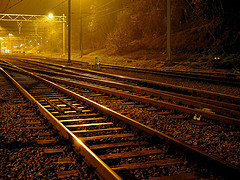 Its route would extend from Pakistan Mint to Sabzazar via Shahnur, Awan Town, Hinjarwal, Niaz Beg, Canal View, Wahdat Road, Ali Town, Salahuddin Road, Bund Road, Islam Park, Dera Gujjran Depot, Mahmood Booti, Salamatpura, Samanabad, Gulshan Ravi, Chauburji, Lake Road, Lakshami Chowk, Railway Station, Sultanpura, UET, Baghbanpura and Shalimar Garden areas.
Its route would extend from Pakistan Mint to Sabzazar via Shahnur, Awan Town, Hinjarwal, Niaz Beg, Canal View, Wahdat Road, Ali Town, Salahuddin Road, Bund Road, Islam Park, Dera Gujjran Depot, Mahmood Booti, Salamatpura, Samanabad, Gulshan Ravi, Chauburji, Lake Road, Lakshami Chowk, Railway Station, Sultanpura, UET, Baghbanpura and Shalimar Garden areas.
The length of Orange Line would also be 27-km out of which, 6.9 km long tracks would be underground, while 20.2 km-long would be overhead upon which six underground and 20 overhead stations would be established.
The central interchange station of Green and Orange lines would also be established besides linking these lines at Ring Road, railway station, airport, and Sports City.
The completion dates of ‘Orange Line’ is in 2015. Initial estimates are that 245,000 people annually would benefit from the Orange Train.
PHASE II:
The completion year for phase II is 2020.
In Phase-II, two more tracks will be laid out. These routes will be called Blue Line and Purple Line.
Blue Line:
 The route length of blue line is going to be 24 km. The ‘Blue Line’ will start from Chauburji and end at College Road, sources said, adding that from Chauburji the line would pass through Mozang Chungi, Shadman Chowk, Jail Road, Mian Boulevard Gulberg, Mian Boulevard Garden Town, Faisal Town and end at College Road.
The route length of blue line is going to be 24 km. The ‘Blue Line’ will start from Chauburji and end at College Road, sources said, adding that from Chauburji the line would pass through Mozang Chungi, Shadman Chowk, Jail Road, Mian Boulevard Gulberg, Mian Boulevard Garden Town, Faisal Town and end at College Road.
Purple Line:
The route length of Purple line is going to be 19 km. Purple line would start from Bhaati Chowk and end at Allama Iqbal International Airport. The line would pass through Bhaati Chowk, Brandreth Road, Railway Station, Allama Iqbal Road, Dharampura, Ghazi Road and end at Allama Iqbal International Airport
The Train Capacity:
One unit of air-conditioned train will have the seating capacity of 500 passengers.
Stations:
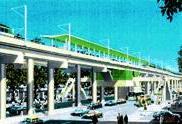
Environmental Concerns?
Just like with every Mega project, voices of dissent have started appearing for the project where people have shown concern for environment and noise levels of elevated trains. Dawn‘s editorial on Jult 12, 2007 covers these voices very concisely and I’ll quite the editorial here:
The first two lines will cost $3.3 billion. In real terms, the cost of the project is yet to be worked out. Surely, notes of dissent are expected to start pouring in. The economists are going to question the heavy debt the project will incur for the government and the citizens, while the opposition politicians are most definitely going to give their own colour to these lines and the sabza group may soon be out to enumerate the effects of this development on Lahore’s environment. Some of these points may be very valid and should elicit a thoughtful response from the government. There can be no moving ahead without this exercise. The sooner this essential exercise is carried out the better it would be for everyone.
Noise: I couldn’t find the details on expected noise levels around elevated portions of the track but noise is definitely going to travel far and away if sound barriers are not constructed around the tracks. More than normal decibels of noise are already witnessed around Pakistan Railway’s elevated track which runs from Lahore Station to Badami Bagh.
Previous Light Rail Studies or Projects:
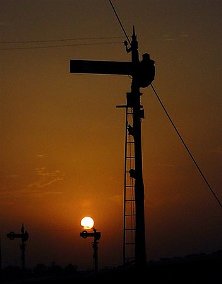 The current project is definitely not the first attempt to build a rail based mass transit for Lahore. In 1991 during Nawaz Sharif’s termas prime minister, the feasibility of a light rail transit system was determined by Japanese development organisation (JICA). It had proposed a 13 kilometre long system. The study was reviewed and updated as part of the World Bank funded “Lahore traffic and transport studies” in 1993.
The current project is definitely not the first attempt to build a rail based mass transit for Lahore. In 1991 during Nawaz Sharif’s termas prime minister, the feasibility of a light rail transit system was determined by Japanese development organisation (JICA). It had proposed a 13 kilometre long system. The study was reviewed and updated as part of the World Bank funded “Lahore traffic and transport studies” in 1993.
The system’s cost was estimated at about US $400 million, but with better network coverage. In 1995 Japan proposed financing the original scheme with grants and loans of about US $495 million, but the project could not be implemented due to many reasons.
Fares: Back in July 2007, it was reported in Daily Times that Passengers of the Lahore Rapid Mass Transit (LRMT) would be charged Rs 125 to Rs 140 to travel from one end to the other of the 27 kilometre-long Green Line.
“Sources associated with the project told Daily Times on Thursday that this (Rs 125-Rs 140) one-side fare had been calculated after taking into account the rendered $2.5 billion cost of the project, which is expected to be completed by 2011. Sources said that to pay back the loan likely to be incurred on the LRMT project, the government would have to charge high fares from the passengers. Currently, the public transport fare from Kahna to Shahdara is between Rs 20 to 25. By 2011, it would rise between Rs 25 and Rs 30. They said that to charge a passenger of the LRMT Rs 30 for a one-side visit, the government would have to give a subsidy of at least Rs 100 per person, which was not possible for the government.
While Rs 140 one way fare indeed looks ridiculous right now, passengers may end up paying much more than road transport. The benefiit however will be ease of travel, no traffic jams and hopefully a strict adherence to time table.
Hope: Many years ago I took a course in Engineering Economics. I still remember one sentence from my text book. It read as:
“All mega projects should be built as soon as possible after their design is done and funding is secured otherwise opposition to the project grows on POLITICAL basis.”
When we look around the mega projects of Pakistan, it appears so true. If big projecs are not started quickly they never will because somebody will always find a reason to do politics on the issue. In the end we sincerely hope the project sees the light of the day and does not end like the one in works for Karachi (called KMTP/KCR) for the past 33 years. Lets all hope for the best and we will continue to add updates on this project in the comments section below.
References
(1) Metroblogging Lahore
(2) Dawn Editorial of July 12, 2007 here.
(3) The News, February 26, 2006 here.
(4) MVA Consultancy
(5) Business Recorder Edition of June 10, 2007
(6) The Daily Times Edition of March 14, 2006
(7) ZeeNews edition of March 5, 2007
(8) Lahore Signs Light Rail MoU: September 1, 2002.
(9) Daily Times Edition of July 7, 2007
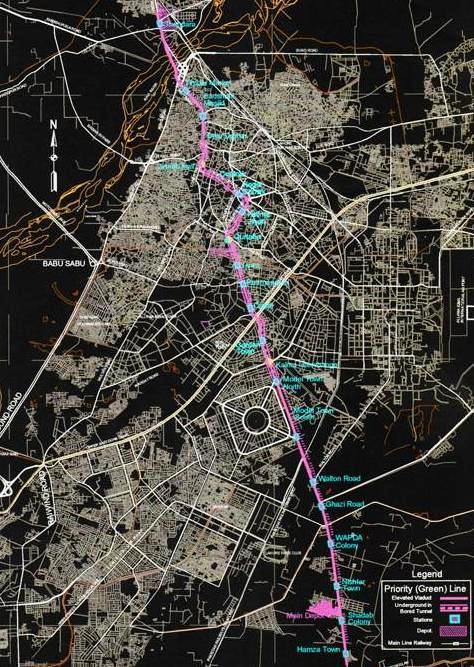




















































All we need is a leadership who is motivated either for its own benefits (commissions, etc) or may be for the betterment of people of Pakistan (I have doubts in this option), to complete these kind of projects otherwise they remain good in papers only.
One more thing that comes to mind is there is no Mass Transit Authority for Lahore yet. I believe the project is being carried out by the Govt of Punjab with funding from Asian Development Bank.
I believe Punjab’s Provincial Assembly needs to pass some basic regulation for providing legal cover on who is going to implement this project so as to avoid future conflicts. Otherwise if the current govt changes hands the project may die too. Provincial legislature should do law making to give this project to either a subsidiary dept of provincial govt OR a private company OR make law for a brand new ‘mass transit authority’ for the city.
There was a question about whether Delhi Metro is economically sustainable. The farebox collections of Delhi Metro have provided it an operational profit from day one. However, since the interest costs for such a heavy investment are high, DMRC is not profitable after including interest costs. It aims to stay profitable through its revenues from its real-estate operations.
Throughout the world, metros are usually not profitable by themselves, but if you account for the economic benefits they provide, they make sense as investments. One metro that is profitable is the Hong Kong MTR, but only because of its real-estate operations. Besides leasing out space for malls, restaurants and other concessions within stations (that DMRC is also doing), it actually invests in property development, particularly above or near metro stations. Delhi Metro has constructed an IT park and is planning other real-estate developments. Even after the revenues from these, I still think it will not break even. But it will still make sense if one considers all the economic, social and environmental benefits it provides.
One more thing – while the maximum fare on Delhi Metro is Rs. 22, the fares range from Rs. 6 through 22. The average commuter pays about Rs. 12 for a commuting distance of roughly 15 kms.
Aqil:
Phase I of the Delhi Metro Rail Project was constructed between 1998 and 2006. The total length of the Phase I network is about 65kms, with about 13kms underground and the rest elevated. The total completed project cost was Rs. 10,500 crores. It is hard to directly convert this to dollars due to exchange rate changes and inflation during the construction period (various parts of this cost were incurred at different times). But at today’s exchange rate, this is roughly $2.6 billion. Since the Indian and Pakistani rupee have largely moved in similar ways and also inflation has been comparable, if you convert the INR 10,500 crores into PKR at today’s exchange rates, you would get a relatively accurate picture of the cost of the project in PKR (more than when the conversion is done into dollars).
Of the 65kms network, roughly 13 kms is underground and the rest is elevated. When doing cost estimates, one needs to account for underground and elevated lines separately (and also at-grade lines, if any) since the costs are obviously very different. A good rule of thumb is that an elevated line costs about 5-10 times as much as an at-grade line and an underground line can cost twice as much as an elevated one.
In the Phase II of the Delhi Metro project, which is currently under construction with a targeted completion date of 2010, a total of 121kms of lines are under construction. The cost of this phase of the project is significantly lower than the first phase, mainly because
a. Phase II is being constructed by Delhi Metro Rail Corporation (DMRC) without the use of external design consultants, due to the experience gained in-house. In fact, Line 3 of Phase I (which is the longest line at 32 kms, with both underground and elevated sections) was constructed by DMRC in-house, at a significantly lower cost than Lines 1 and 2.
b. The new lines in Phase II are being built in standard gauge, rather than broad gauge. In Phase-I, broad gauge was chosen by the Government despite DMRC’s preference for standard gauge due to turf wars with the Indian Railways ministry and the inability of the then fledgling DMRC to do anything about it. Standard gauge reduces costs both because the civil structures are somewhat lighter and also because the market for equipment for standard gauge is more competitive (it is by far the most common gauge for metro networks worldwide)
As a result of these cost savings, Phase II of the network is being constructed for about 20000 crores. The exact cost is somewhat uncertain because one of the lines – the high-speed link to the airport has just undergone a redesign that has led to cost escalation (more of it will be underground to protect the heritage of the areas of Lutyens’ Delhi it will be passing through). But in any case, given the greater proportion of underground lines in Phase II than in Phase I, the cost per km is significantly lower than for Phase I.
For Lahore, I would assume a similar construction cost – Lahore like Delhi is a relatively flat city and has similar soil characteristics (bedrock and alluvial soil). Things like crossings over bridges or tunnels under water bodies (rivers, canals) adds significantly to costs. The Phase I network in Delhi has a 0.5km long bridge over the Yamuna and Phase II will add another similar bridge at a different location over the Yamuna river. I don’t know if the Lahore network proposes bridges over the Ravi or the canals, but those costs need to be added too.
Finally, regarding fares – the highest fare on the Delhi Metro is Rs. 22. This is for a roughly 50 kms trip, involving two transfers. Delhi Metro is also launching a large network of feeder buses to move people from near their homes to the nearest metro station. That will add some commuting cost too (its fare is not included in the metro fare) – typically three to five rupees per trip depending on distance. Thus, the maximum fare is roughly about Rs. 25-28, for a distance of roughly 55-60 kms. This is lower than the bus fares for similar distances, and with much higher comfort and reliability.
For Lahore Mass Transit enthusiasts, here is a 1960 photo of ‘Ganz’ railcar that used to run between Lahore and Wagah until 1979-80. Many Lahoriites may remember seeing it idling in Lahore yard siding near the Washing Lines. Here is the photo